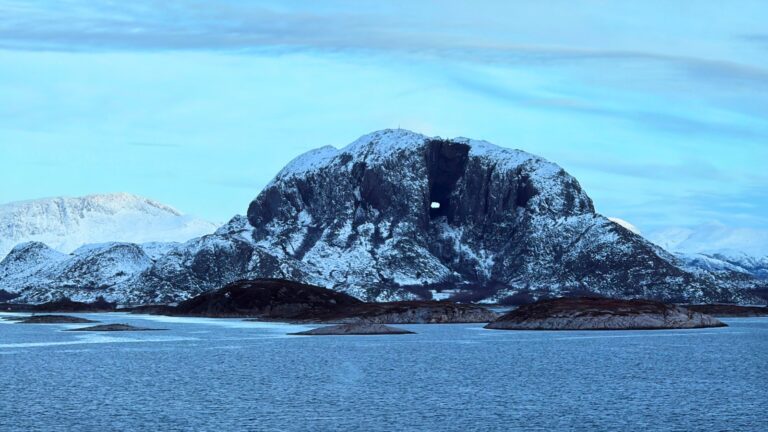A striking mountain with a hole straight through its centre, Torghatten is one of the most memorable landmarks along Norway’s Helgeland coast.
Sailing past Torghatten never loses its magic. I have seen the mountain in every season, but on my most recent trip north on Fred Olsen’s Balmoral it looked better than ever.

It was a clear and crisp November afternoon, the air was cold enough to sting, and a fresh layer of snow sat across the mountain like icing sugar.
Moments like this are why I love travelling along Norway’s inside passage on smaller ships. The big vessels have to head out to sea for long stretches, but ships like Balmoral can follow the sheltered route between the islands, where the scenery is never-ending.
The Helgeland coast is full of memorable sights but two in particular always stand out. The Seven Sisters mountain range creates one of the great panoramas of coastal Norway.
Torghatten, with its unmistakable hole through the middle, provides the perfect counterpoint. Together they form one of the most dramatic sequences of scenic cruising anywhere in the country.
Introducing Torghatten
Torghatten is a granite mountain on the Helgeland coast that immediately catches the eye. The mountain rises sharply from otherwise low-lying islands and its rounded shape makes it look almost like a giant hat.
What makes it truly remarkable is the enormous hole than runs straight through the centre of the mountain. It is a sight that seems almost too perfect to be natural and is visible from many miles away at sea.
Although the hole looks small from the water, its scale only becomes clear once you get ashore. It stretches more than one hundred metres high and almost two hundred metres long, making it possible to walk right through the opening and look out across the landscape on the other side.
A Mountain Formed By Ice Age Forces
The distinctive shape of Torghatten was created during the last Ice Age around ten thousand years ago. The mountain is made of hard granite that resisted erosion more effectively than the surrounding rocks.

As the ice sheet moved across the region it exploited natural weaknesses within the stone, slowly carving out the tunnel. The result is one of the most photogenic geological features on the Norwegian coast.
Torghatten In Legend And Folklore
No unusual landmark in Norway is complete without a good story and Torghatten is no exception. In Helgeland folklore, the mountain and its hole are tied to the tale of Hestmannen, the giant horseman, and Lekamøya, a young maiden.
According to the story the giant pursued her across the coast in a fit of unreturned affection. As dawn approached and he realised he would not catch her, he fired an arrow in anger.
The Troll King of Sømna threw his hat to protect her, the arrow pierced the hat, and sunrise turned them all to stone. The hat became Torghatten and the maiden and her sisters became the Seven Sisters mountain range.
The legend has no basis in geology but it adds colour and imagination to what is already a remarkable natural landmark.
Hiking To The Hole
From the water it is hard to believe you can walk up to the hole but the hike is both manageable and rewarding.
A marked path from the eastern side leads up stone steps to the opening and most people complete the climb in about twenty to thirty minutes. The ground can be uneven so good footwear is recommended.
Once inside the hole the views are superb. One side looks over the sea and islands while the other opens onto the Helgeland coast. The scale of the space is incredible and standing within the opening offers a tangible sense of how powerful the Ice Age forces must have been.
A few royal signatures are carved into the rock around the entrances, including those of King Oscar the second, King Olav the fifth and King Harald the fifth, which adds a small historical curiosity to the visit.
More ambitious hikers can climb to the top of the mountain but this is a demanding route that should only be attempted by experienced walkers.
A Tragic Chapter in Torghatten's Story
Torghatten is also known for one of the darkest moments in Norwegian aviation history. On 6 May 1988 Widerøe Flight 710 crashed into the mountainside while attempting to land at Brønnøysund in dense fog. All thirty six people on board died.
A memorial now stands at the site and many visitors take a quiet moment to reflect on the tragedy when exploring the area.
How To Visit
Brønnøysund is the gateway to Torghatten. It sits about fifteen kilometres from the mountain and is well connected by air, road and sea. Flights operate to Bodø and Trondheim, and both Hurtigruten and Havila serve Brønnøysund on their coastal voyages.
In spring and summer some southbound sailings offer guided hikes to the hole. Independent travellers can reach the trailhead by car, taxi or bicycle.
The hike is short but the views are exceptional, making Torghatten one of the most memorable stops on the Helgeland coast.

